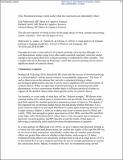| dc.contributor.author | Mahowald, Kyle Adam | |
| dc.contributor.author | James, Ariel | |
| dc.contributor.author | Futrell, Richard Landy Jones | |
| dc.contributor.author | Gibson, Edward A | |
| dc.date.accessioned | 2019-11-08T17:20:35Z | |
| dc.date.available | 2019-11-08T17:20:35Z | |
| dc.date.issued | 2017 | |
| dc.identifier.issn | 0140-525X | |
| dc.identifier.issn | 1469-1825 | |
| dc.identifier.uri | https://hdl.handle.net/1721.1/122804 | |
| dc.description.abstract | Branigan & Pickering (B&P) claim that the success of structural priming as a method should “end the current reliance on acceptability judgments.” Structural priming is an interesting and useful phenomenon, but we are dubious that the effect is powerful enough to test many detailed claims about specific points of syntactic theory. | en_US |
| dc.publisher | Cambridge University Press (CUP) | en_US |
| dc.relation.isversionof | http://dx.doi.org/10.1017/s0140525x17000504 | en_US |
| dc.rights | Creative Commons Attribution-Noncommercial-Share Alike | en_US |
| dc.rights.uri | http://creativecommons.org/licenses/by-nc-sa/4.0/ | en_US |
| dc.source | Prof. Gibson via Courtney Crummett | en_US |
| dc.title | Structural priming is most useful when the conclusions are statistically robust | en_US |
| dc.type | Article | en_US |
| dc.identifier.citation | Mahowald, Kyle et al. "Structural priming is most useful when the conclusions are statistically robust." Behavioral and Brain Sciences, 40 (2017): e302 © 2017 Cambridge University Press | en_US |
| dc.contributor.department | Massachusetts Institute of Technology. Department of Brain and Cognitive Sciences | en_US |
| dc.relation.journal | Behavioral and Brain Sciences | en_US |
| dc.eprint.version | Author's final manuscript | en_US |
| dc.type.uri | http://purl.org/eprint/type/JournalArticle | en_US |
| eprint.status | http://purl.org/eprint/status/PeerReviewed | en_US |
| dspace.date.submission | 2019-11-06T16:23:53Z | |
| mit.journal.volume | 40 | en_US |
